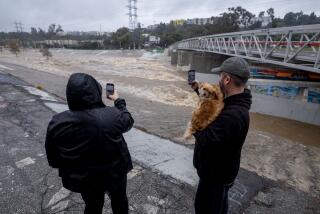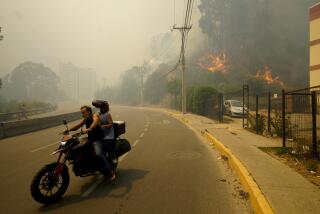Drought and heat waves are much more likely to mix, researchers say
A drought can make a hot day hotter, while a heat wave can make dry conditions even drier. Now scientists are making the case that heat waves and droughts have become more likely to overlap throughout most of the United States.
In fact, the longer and hotter the heat wave, the bigger the jump in the odds that it coincided with drought conditions, according to a study published Monday in the Proceedings of the National Academy of Sciences.
“Despite an apparent hiatus in rising temperature and no significant trend in droughts, we show a substantial increase in concurrent droughts and heatwaves across most parts of the United States,” wrote Omid Mazdiyasni and Amir AghaKouchak, who study climate and hydrology trends at UC Irvine.
AghaKouchak, an assistant professor of civil and environmental engineering, and Mazdiyasni, a postdoctoral researcher in his lab, examined heat and drought conditions between 1990 and 2010 and compared them with conditions in a baseline period of 1960 through 1980.
They defined a drought as a time when the probability of rain, snow or other precipitation was about 80% below the median level. They used various definitions of a heat wave, but all involved at least three consecutive days of temperatures that were in the top 15% for the “warm season” of May through October.
No matter how they defined a heat wave, in most parts of the country these stretches of hot weather were more likely to overlap with a drought in recent decades than they were in the earlier decades. The increase was “substantial” in the South, Southwest and parts of the West. Meanwhile, the odds of a combined heat wave and drought fell in many Northern states and in parts of the Midwest.
The more extreme the heat wave, the greater the increase in events that coincided with a drought, the researchers found. That trend was most pronounced in parts of the West and Southeast, where the most severe heat waves – those with temperatures exceeding the 95th percentile for an entire week – overlapped with a drought at least 50% more often between 1990 and 2010 than they did between 1960 and 1980. In certain parts of Mississippi, Alabama, Louisiana, Texas, Arkansas and New Mexico, the frequency of these extreme double whammies nearly doubled, AghaKouchak said in an interview.
The UCI researchers also calculated the odds that a given amount of the contiguous United States would experience a drought and heat wave simultaneously. In most cases, the two events were more likely to coincide in the years between 1990 and 2010 than they were in 1960 through 1980. Once again, they noticed that the more extreme the heat wave, the bigger the difference between the two time periods.
Though California is in its fourth year of an epic drought, the Golden State fared pretty well in the analysis. Depending on the definition of heat wave, certain parts of California – particularly in Imperial County near the border with Mexico and in the areas around the Shasta-Trinity and Mendocino national forests north of the San Francisco Bay Area – experienced fewer heat waves combined with droughts as time went on.
AghaKouchak said he wasn’t surprised by that result.
“In California we are used to short-term hot spells,” he explained. “That said, had we included data from the past five years, we might have seen an increase in heat waves.”
In December, AghaKouchak, Mazdiyasni and their UCI colleagues published a paper in Geophysical Research Letters that reported record-high temperatures in cities throughout California during a January 2014 heat wave. (In Redding, for instance, the maximum daily temperature during a January heat wave was 87% higher than the historical average for that time of year.) These records were set despite the fact that at the time, drought conditions were still about 50% better than during the 1977 drought.
In that study, the researchers acknowledged that droughts and heat waves “do not necessarily happen at the same time,” they wrote. But when they do, they “could lead to a compound extreme event with significant impacts.”
Follow me on Twitter @LATkarenkaplan and “like” Los Angeles Times Science & Health on Facebook.







